
Dinwiddie is an unincorporated community, census-designated place (CDP), and the county seat of Dinwiddie County, Virginia, United States. It was first listed as a CDP in the 2020 census with a population of 619.
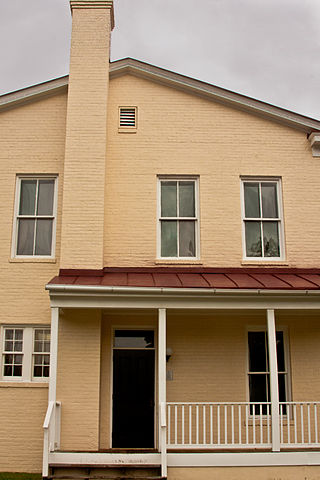
Dinwiddie County Court House is a historic courthouse building located at the junction of U.S. 1 and VA 619 in Dinwiddie, Dinwiddie County, Virginia. It was built in 1851, and is a two-story, brick temple-form building in the Greek Revival style. It measures approximately 37 feet (11 m) wide and 78 feet (24 m) long, and features a front portico added in 1933. The courthouse was the site of the Battle of Dinwiddie Court House in the closing stages of the American Civil War. The Dinwiddie County Historical Society is currently located in this building.

Five Forks Battlefield is a battlefield of the American Civil War, the location of the Battle of Five Forks, in which Union Army forces broke through Confederate Army lines, opening the way to gain control of the last rail line to besieged Petersburg. The Confederate loss caused them to abandon that city, which undermined the defense of Richmond, the Confederate capital. Final surrender of the Confederate forces would occur at Appomattox Courthouse eight days later.

Wales is a historic house and site in Dinwiddie County, Virginia. It was built in 1730 by Captain Howell Briggs of the Virginia Militia on a tract of land a few miles west of Petersburg, Virginia, in what was then Prince George County. Dinwiddie County was formed from Prince George in 1752. Briggs is said to have named his plantation "Wales" after the Prince of Wales.

Ker Place, sometimes spelled Kerr Place, is a historic home located at Onancock, Accomack County, Virginia. It was built in 1799, and is a two-story, five-bay rectangular Federal-style dwelling with a central projecting pedimented pavilion on both the front and rear elevations. It has a cross-gable roof and a two-story wing which originally was a 1+1⁄2-story kitchen connected to the house by a hyphen. In 1960, the house and two acres of land were acquired by, and made the headquarters of the Eastern Shore of Virginia Historical Society, which operates it as an early 19th-century historic house museum.

Carrsbrook is a historic home and farm complex located near Charlottesville, Albemarle County, Virginia. The main house was built about 1785, and is a five-part Palladian style dwelling. It has a central, projecting 2+1⁄2-story, three-bay-wide section flanked by 1+1⁄2-story, single-bay wings connected by hyphens. The front facade features a single-story dwarf portico, supported by Doric order columns. From 1798 to 1815 the house served as the residence and school of Thomas Jefferson's ward and nephew, Peter Carr.
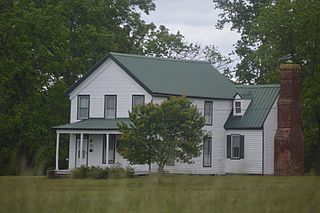
Stony Creek Plantation, also known as Shell House, is a historic plantation house located at DeWitt, Dinwiddie County, Virginia. The original section was built about 1750, and is a 1+1⁄2-story, three-bay, center-hall plan house. It would have been built by enslaved African Americans. They likely cultivated tobacco and mixed crops by the time this plantation was developed.
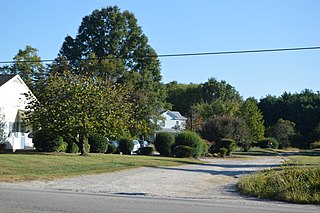
Burlington is a historic plantation house located near Petersburg, Dinwiddie County, Virginia. It was built about 1750, and is a 1+1⁄2-story frame dwelling with a center-passage, double-pile plan. It has a slate gable roof with dormers. A one-story wing was added during its restoration in 1954.
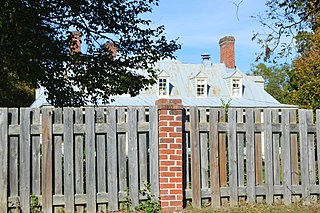
Mansfield is a historic plantation house located near Petersburg, Dinwiddie County, Virginia. It was built in stages starting about 1750, and is a 1+1⁄2-story long and narrow frame dwelling with a hipped roof. It has a hipped roof rear ell connected to the main house by a hyphen. It features an octastyle Colonial Revival porch stretching the full length of the front facade.

Zehmer Farm is a historic home and farm complex located near McKenney, Dinwiddie County, Virginia. The farmhouse was built about 1905, and is a one-story, frame L-shaped dwelling with a broad hipped roof and wings added to both sides. Also on the property are a collection of outbuildings and farm structures – including animal shelters, corn crib, flue-cured tobacco barns, dairy barn and milk houses, and the sites of tenant houses, a butcher house, fire-cured tobacco barns and a sawmill.

Rose Bower is a historic farm complex located at Stoney Creek, Dinwiddie County, Virginia. The first building on the property is the 1+1⁄2-story kitchen built about 1818 as the primary dwelling. The main dwelling was built in 1826 during the Federal period. It is a two-story, frame, hall-parlor-plan house with a 1+1⁄2-story rear ell. Also on the property are a contributing early well cover, smokehouse, and the Rose family cemetery.

Glen Arvon, originally known as Glenarvon, is a historic plantation house and farm located near Bremo Bluff, Fluvanna County, Virginia. The main house was built in 1836, and is a two-story, five bay, brick dwelling in the Greek Revival style. It measures 50 feet by 40 feet and is topped by a shallow hipped roof with balustrade. The front facade features a two-story Greek Doric order portico. Also on the property is the contributing two-story, brick servant's house. The house is a twin of Point of Fork, as they were built by brothers William and James Galt.

Point of Fork Plantation is a historic plantation house and farm located near Columbia, Fluvanna County, Virginia. The main house was built about 1830, and is a two-story, five bay, brick dwelling in the Greek Revival style. It measures 50 feet by 40 feet and is topped by a shallow hipped roof with balustrade. The front facade features a large two-story tetrastyle Greek Doric order portico. Also on the property are a contributing servant's house and office. The house is a twin of Glen Arvon, as they were built by brothers William and James Galt. In March 1865, Federal troops under General Philip Sheridan occupied the plantation and Sheridan set up headquarters in the house.

Melrose, also known as the Ellen Miyagawa House, is a historic home located near Fork Union, Fluvanna County, Virginia. It was built in 1813, and is a 2-story, five bay, rectangular brick dwelling in the Federal style. It sits on an English basement and has a slate covered gable roof with pedimented ends. A 1+1⁄2-story frame addition was built in 1978.

Fork Church is a historic Episcopal church located near Ashland, Hanover County, Virginia. It was built in 1736, and is a one-story, gable roofed brick building. It measures approximately 34 feet by 74 feet and has walls 22 inches thick. The front facade features a small pedimented porch supported on square brick columns, both probably added in the early-19th century. Also on the property is a contributing church cemetery. Among the more-notable persons who often attended services at Fork Church were Patrick Henry, Dolley Madison, and the novelist Thomas Nelson Page. From 1893 to 1903, Fork Church's rector was the Reverend S. S. Hepburn, grandfather of actress Katharine Hepburn.

Church Quarter is a historic home located at Doswell, Hanover County, Virginia. It was built in 1843, and is a one-story, three-bay, gable-roof, log dwelling. It has exposed logs with V-notching and two exterior end chimneys. Also on the property are contributing two late-19th / early-20th century outbuildings and the ruins of a brick orangery, known locally as the flower house.

Powhatan is a historic home located near Five Forks, James City County, Virginia. The house was designed by its owner Richard Taliaferro and built about 1750. It is a two-story, five bay by two bay Georgian style brick dwelling. It has a hipped roof with dormers and features two massive interior end T-shaped chimneys. The house was gutted by fire during the American Civil War. It was thoroughly restored in 1948.
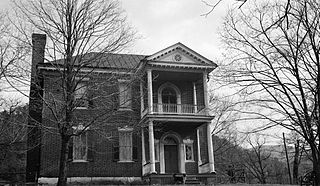
Fotheringay is a historic plantation home located near Elliston, Montgomery County, Virginia. The house was built about 1796, and is a two-story, five bay brick dwelling with a hipped roof and deep two-story rear ell. It features a projecting two-level provincial type portico. The house was originally built as a three bay dwelling with the portico on the southernmost bay. It was expanded to the full five bays in the 1950s. It was the home of Col. George Hancock (1754–1820).

Adam Wall House is a historic home located near Prices Fork, Montgomery County, Virginia. It was built about 1850, and is a two-story, five-bay, log dwelling with a modified hall and parlor plan. It is sheathed in weatherboard, and has a gable roof, exterior brick end chimneys, one-story porch, and a two-story frame ell. Also on the property is a contributing log meathouse or smokehouse.
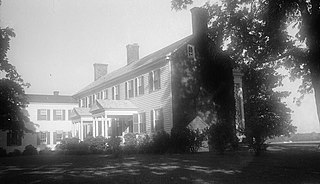
Vaucluse is a historic plantation house located near Bridgetown, Northampton County, Virginia. It is a complex, two-story, ell-shaped brick and frame structure with a gable roof. Attached to the house is a 1+1⁄2-story quarter kitchen with brick ends. The brickended section of the house was built about 1784, with the addition to the house added in 1829. The annex connecting the house with the old kitchen was probably added in 1889. It was the home of Secretary of State Abel P. Upshur (1790–1844) who died in the USS Princeton disaster of 1844. His brother U.S. Navy Commander George P. Upshur (1799–1852), owned nearby Caserta from 1836 to 1847.
























